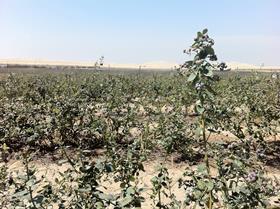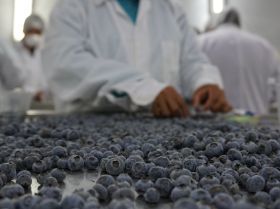
A return to normal growing conditions following the departure of El Niño and the continued rise in global consumption augur well for the new South American blueberry campaign, which kicked off last month and is expected to get into full swing by mid-September.
Much of the focus in the run up to the new season has been on Asia, where Uruguay claimed victory in its three-way race with Argentina and Peru to secure access to the booming Chinese market with the signing of the new import protocol at the end of July. But with consumption growing across virtually every market, all regional suppliers have the opportunity to increase their shipment volume.
In Argentina, the new government of president Mauricio Macri has provided fresh impetus to international trade talks and created a more favourable climate for fresh produce exports. A recently established Directorate of Fruits and Vegetables is working hand in hand with the industry to open up new markets such as China, South Korea and Taiwan.
 Following a visit by AQSIQ inspectors to production areas in December last year, the committee is optimistic that China will open before the end of the year. “Members of the Chinese plant health authority are expected to attend the International Blueberry Organisation Summit on 20-22 September, where we a timetable for the signing of the protocol could be agreed,” says Inés Peláez of the Argentine Blueberry Committee (ABC).
Following a visit by AQSIQ inspectors to production areas in December last year, the committee is optimistic that China will open before the end of the year. “Members of the Chinese plant health authority are expected to attend the International Blueberry Organisation Summit on 20-22 September, where we a timetable for the signing of the protocol could be agreed,” says Inés Peláez of the Argentine Blueberry Committee (ABC).
Barring any nasty surprises from Mother Nature over the next few weeks, production in Argentina is set to bounce back after last year’s dip. The ABC had yet to release its official forecast at the time of going to press but Peláez notes that the benign winter has produced relatively few hard freezes and sufficient chill hours to ensure normal plant development. “It’s a little early to give a concrete prediction on volumes but quality-wise we think it’s shaping up to be a good season,” she says.
The introduction of new varieties and growing techniques has enabled Argentina to extend its supply window by bringing forward the start of the season to August. Most of this early fruit sold domestically or in regional markets like Brazil as it doesn’t make sense to ship further afield until US supplies have come to an end in September.
Nevertheless, Peláez says this is good news for the struggling regional economies as it provides much-needed jobs over a longer period. Concordia in the province of Entre Ríos, for example, is home to 38 per cent of the country’s total planted area and the industry generates employment for more than 10,000 people.
Meanwhile Peruvian blueberry exporters are hopeful that the official signing of the import protocol could take place during the visit of president Pedro Pablo Kuczynski to China this week. Camposol in particular has been ramping up its blueberry production in recent seasons, tripling its output to 14,000 tonnes in the past year alone.
Concordia, together with Salto in Uruguay, will be the scene of this month’s IBO 2016 summit, the most important event in the blueberry calendar. Bringing together the main producing and exporting countries, it provides an opportunity to discuss and analyse the latest industry trends including new technologies and varieties.
Meanwhile, Uruguayan blueberry exporters are set to renew their focus on new markets this year as production volumes recover after last year’s shortfall. The industry was forced to put their expansion plans on hold in 2015 due to a 19 per cent contraction in volumes caused by El Niño-related weather issues.
According to Diego Castagnasso of Azul Sereno, the 2016 season is progressing smoothly with no major weather-related issues. “The cool autumn has ensured that we have accumulated a sufficient amount of cold hours and the outlook is positive,” he says. “At this stage it’s too early to give concrete forecasts but production should be higher than last year and given the benign climate, the quality of the crop looks to be good.”
The recent opening of the Chinese market for Uruguayan blueberries is a major coup for the industry. The official signing of the import protocol, which requires shipments to be treated with methyl bromide, took place on 29 July and marks a new era for Uruguayan blueberry exports.
Uruguay is well positioned to fill the lucrative early season September/October blueberry window in China before Peru gets into full swing – a gap that Argentina is also looking to supply once it gains access to the market.
Traditional markets like Europe and the US have also been earmarked for export growth this season. Uruguay’s production base has undergone a high degree of consolidation in recent years and today supply is in the hands of just a few companies. The result, says Marta Bentancur of fruit producer association Upefruy, is an industry well positioned to tap into the global growth in blueberry consumption.
“New varieties, greater automation and better handling methods have increased efficiency and raised productivity, making us more competitive on the world stage,” she says.
Castagnasso points out that while emerging markets like China are beginning to take off, consumption also continues to rise in established markets like the US, Germany and the UK.
“It’s difficult to compare growth in different markets as some have only emerged very recently and accurate statistics are hard to come by, but the evidence points to strong increases in markets like Scandinavia, China, South Korea and the Middle East are all growing strongly,” he says.
Logistics are a key factor in sustaining export growth, and finding faster, more cost-efficient ways to reach the market with a better quality product will one of the topics up for discussion at the forthcoming International Blueberry Organisation summit which takes place in in September and will be jointly hosted by Uruguay and Argentina in the cities of Salto and Concordia.
Supply issues are also set to feature prominently at the event that will focus on finding global solutions to a globalised industry.
“All the main producing countries face the same challenges, and there’s no doubt that the industry is moving towards closer collaboration to tackle issues such as climate change, labour shortages and productivity,” says Castagnasso. “Fruit fly and other pests are becoming more of a problem and require an unified approach to finding new a better varieties that adapt to different soils and climatic conditions and produce berries with a longer shelf-life.”



